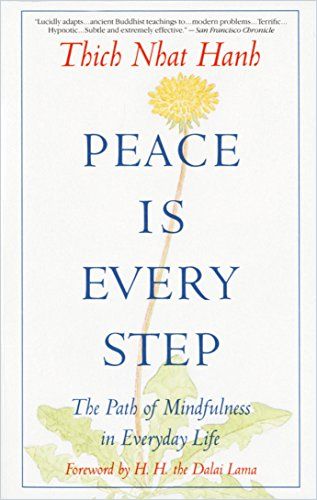Zen master, monk and author Thich Nhat Hanh offers a guide to mindfulness through conscious breathing and other awareness practices.

The Path to Peace
Zen master Thich Nhat Hanh – prolific author of You Are Here; No Mud, No Lotus; and How To Focus, among other books – explains how to experience peace and joy in the here and now. Peace isn’t an external feeling you need to chase, he assures you; it resides within you. Thich Nhat Hanh brought “engaged Buddhism” to the West to empower people to transform the world through love and nonviolence. He offers mindfulness tools to help you embrace the present moment and better manage challenging emotions.
Peace Within
You already possess peace within you. Become aware of your inner peace by slowing down enough to notice it.
Peace is every step. / The Shining red sun is my heart. / Each flower smiles with me. / How green, how fresh all that grows. / How cool the wind blows. / Peace is every step. / It turns the endless path to joy. Thich Nhat Hanh
Smiling increases your awareness of the present moment. Hanh also suggests the simple exercise of saying the words, “in” and “out” to focus your mind on your breath as it becomes gentle and peaceful. When you begin meditating, remove yourself from environments that conflict with your sense of calm. Choose environments that boost your sense of joy.
Moments of Mindfulness
Hanh advises practicing sitting meditation by finding a comfortable, seated position in which your back is straight, your hands are gently resting on your lap and your eyes are half-closed. Pay attention to your breathing and your body’s subtle sensations and try to remain still as you tune into the present moment. For meditating with sounds, he recommends using bells to reconnect you to the here-and-now.
Practice conscious breathing as you walk, Hanh writes, by coordinate your breathing with your steps.If you feel calm and joyful as you walk, you’re meditating correctly.
Life As Art
Acting with integrity and awareness is an art. Focus on being present, Hanh explains, and your creative expression will flow freely as you achieve a state of peacefulness.
Even when we are not painting or writing, we are still creating. We are pregnant with beauty, joy and peace, and we are making life more beautiful for many people. Thich Nhat Hanh
Hope can sometimes be an obstacle that prevents you from living fully in the present moment, Hanh notes. When you constantly cling to feelings of hope that the future will be better than the present, you cannot appreciate the present. Remind yourself, Hanh recommends, that you already have everything that you need.
Embracing Non-Duality
Visualize your feelings as a river, with each water droplet representing a different feeling. Mindfulness practitioners do not focus on eradicating their feelings, but on observing each drop of feeling on the surface of a metaphorical river. They watch and wait as feelings flow past them, disappearing downstream. When you embrace the principle of non-duality and accept your difficult feelings as they are – rather than making a value judgement about them and reacting to them with greater negativity – you transform your feelings into something more beneficial.
Hanh states that transforming your feelings requires you to name your feelings, then accept them as a part of yourself. For example, rather than reject your fear by saying, “Go away, fear. I don’t like you. You are not me,” consider saying, “Hello fear. How are you today?” When you spend time with your fear and approach it with curiosity, you calm the feeling with your mindful attention – as a mother would calm a crying baby.
Release your difficult feelings after you calm yourself with conscious breathing. Analyze the source of your feelings, attempting to manage any factors in your life that might trigger fear. Ultimately, transforming your anger requires addressing its root causes, which, inevitably, stem from within – not from the people or circumstances you blame for your anger – and reflect a lack of self-understanding.
“Mind of Love”
Those who truly love others have compassion; they desire to reduce the suffering of others, while nurturing a mind-set of unconditional love: giving love that’s not contingent on the desire to see others return that love. Practice compassion for others by imagining yourself in their situation, essentially “suffering with” another person.
Hanh wants you to put your loving mind into action: How can you alleviate someone else’s suffering, he asks, and enhance the joy in his or her life? Is there a kind word you could say or a way you could help someone avoid experiencing difficulty? Loving someone requires cultivating a deep understanding of that person, an understanding that precludes staying angry. For example, if someone you love snaps at you, rather than responding with hostility, Hanh would have you reflect on what might be agitating the other person. Loving another person requires understanding his or her needs, suffering and aspirations, as opposed to trying to possess or control the person.
No being exists entirely on its own, but must coexist with everything and everyone else in the universe. You are a part of the natural world. The forests are like your lungs and the sun is like your heart. When you think of yourself as too small, extending only to the limits of you body, you risk damaging your larger self – the world itself.
Compassion and Nonviolence
Practice living mindfully, Hanh urges, carefully considering your daily choices and actions.
When you begin to see that your enemy is suffering, that is the beginning of insight. When you see in yourself the wish that the other person stop suffering, that is a sign of real love. Thich Nhat Hanh
Embracing nonviolence requires people to form connections and communicate. Often, Hanh counsels, people hurt one another because they are suffering themselves and don’t realize that everyone is connected. When you show compassion to others, even during times of suffering, you become joyful in any circumstance and, Hanh exults, spread that joy to others.
Review
Hanh’s writing is direct and inspiring. His gentle sincerity and heartfelt desire that you treat yourself, others and the world at large with love shines through. Even a superficial read should break down any cynicism or reticence about Hanh’s methods and philosophy. This is an excellent starting place for those curious about Eastern thought; yet the text also remains worthy and helpful for experienced meditators or those already grounded in Hanh’s particular approach. Some Zen masters present their ideas with a more gnomic obliqueness. Hanh strives for clarity. He wants you to understand how he deals with the world and with his own consciousness, and to embrace his universe of calm thought and uplifting kindness.







